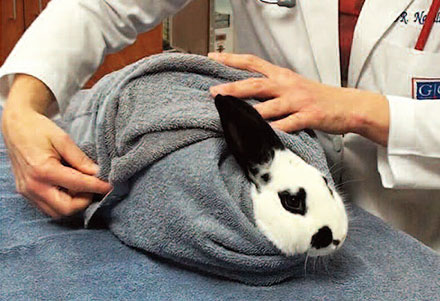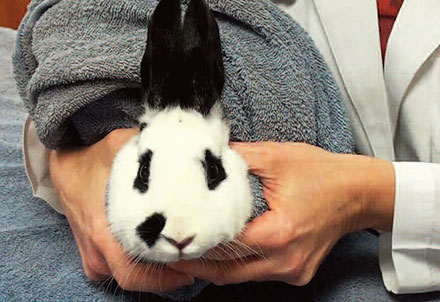Why syringe feed?
Slowing of the gut is a very common medical problem seen in small herbivores. A cornerstone of treatment is delivery of food containing high dietary fiber and proper syringe-feeding technique is essential.
What will I need?
Equipment needed includes a:
- High fiber diet such as Emeraid Herbivore
- Large towel
- Hard, flat surface to place your pet
- Syringe(s) of appropriate size
What can go wrong?
The most important potential complication of syringe feeding formula is an aspiration or inhaling formula down the wrong “pipe”. The inhaled formula can lead to pneumonia or even severe blockage of the airway and death.
STEP-BY-STEP INSTRUCTIONS
-
- Prepare formula fresh for each feeding. Follow label directions since formula that is too watery will increase the risk of inhalation.
- Place a towel on a hard, flat surface, then place your pet in the center of the towel. Create a pet “burrito” by first covering the rump, then fold toweling over each side. Tuck any remaining material under the chin and over the forefeet.

-
- Tuck your pet against your side using your forearm.
- Gently grasp the head with that hand, placing an index finger directly under the chin, and a thumb at the base of the skull. Place remaining fingers on the chest to prevent movement.

-
- Although the pet’s head may be gently elevated, it is less stressful for your patient if you lower your head in order to visualize the mouth and to monitor chewing.
- Gently insert the syringe into the gap between the incisors and cheek teeth.

- The first mouthful fed should be very small, no more than 0.2 to 0.5 ml of formula to ensure active chewing. Never feed more than 1 ml of formula at a time. Never dispense food while your pet is vocalizing since these practices increase the risk of inhaling.
- GO SLOWLY. Syringe feeding can be a time-consuming process that requires patience.
- Follow the meal by SLOWLY syringing at least 5-10 ml of water. Small herbivores need roughage in their diet long-term; therefore Emeraid Herbivore should not be fed as the sole source of nutrition for more than 5 to 7 days.

